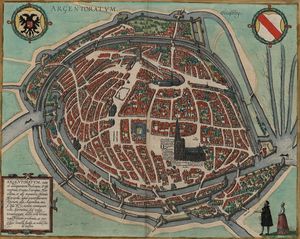Johannes Gutenberg
Who was Gutenberg?

Johannes Gutenberg was named Man of the Millennium by the American A&E Network in 1999. But what did he do to deserve this honour? He invented letterpress printing with movable type!
With his new printing process, Gutenberg replaced traditional methods of book production, such as copying by hand and woodblock printing. Thanks to his invention it became possible to produce large quantities of books faster and cheaper. His most important work is probably the Gutenberg Bible, named after him. His invention spread throughout Europe within a very short period of time, thus triggering a media revolution that had a decisive influence on social developments such as humanism and the Reformation.
Johannes Gutenberg is the eponym of the International Gutenberg Society and as an international association for the research and development of printing technology and script-oriented media, it is an important goal of ours to keep his legacy alive. For this reason, we have compiled here all the essential facts and assumptions about the great inventor and his work. Learn more about Gutenberg's life and his invention:
The episode "How to make a Christmas print" of the series "SWR Handwerkskunst" shows the process of letterpress printing.
Gutenberg´s Teens

What did Gutenberg's training path look like? What was Mainz like during his youth and how did it affect his life? Find out here!
Gutenberg's final years

The view that Johannes Gutenberg was bankrupt after separating from his business partner Johannes Fust and died impoverished and lonely is long outdated. But what do we actually know about the end of his life? Find out here in the last section of our knowledge series about the great inventor.
YouTube channel of the Institute for Book Science of the Johannes Gutenberg University Mainz

As a follow-up to the manifold activities in the Gutenberg year 2018, the Mainz Institute of Book Science was able to publish its own YouTube channel with nine films each in German and English on "Gutenberg und die Erfindung des Buchdruck" / "Gutenberg and the impact of printing in Western culture" on the Internet. The production of letters, casting, the printing press, the exclusion of typesetting, the Gutenberg Bible, rubrication and illumination, the Göttingen sample book, the spread of the art of book printing during the incunabula period and the mechanisation of typesetting production in the 19th century are presented. These films were produced for the Enhanced E-Book on Gutenberg by Rowohlt, who published them as Digibuch Plus in 2013.
Since the 6th edition of the Gutenberg paperback is currently being published in German by Rowohlt and the 1st edition in English by Haus-Publishing in London in early summer, these films will also be included in the e-book by QR code in print and by link.
We are happy to recommend these films to your attention:
The Gutenberg Bible distributed throughout the world:
Austria
Vienna: 2 volumes (paper)
Belgium
Mons: 1st volume, incomplete (paper)
Antwerp: 2 volumes (paper)
Denmark
Copenhagen: 2nd volume (paper)
France
Paris: 4 volumes (paper), 2 volumes (parchment)
Saint Omer: Volume 1 (paper)
Germany
Aschaffenburg: 2 volumes (paper)
Berlin: 2 volumes (parchment)
Frankfurt am Main: 2 volumes (paper)
Fulda: 1st volume (parchment)
Göttingen: 2 volumes (parchment)
Kassel: 1st volume (paper)
Leipzig: 4 volumes (parchment)
Mainz: 2 volumes (paper), 2nd volume (paper)
Munich: 2 volumes (paper)
Schweinfurt: Fragment, 13 sheets (paper)
Stuttgart: 2 volumes (paper)
Trier: 1st volume (paper)
Schleswig: 1st volume, fragment (paper)
Great Britain
Cambridge: 2 volumes (paper)
Edinburgh: 2 volumes (paper)
Eton: 2 volumes (paper)
London: 2 volumes (paper), 4 volumes (parchment), 2nd volume (parchment)
Manchester: 2 volumes (paper)
Oxford: 2 volumes (paper)
Japan
Tokyo: 1st volume (paper)
Poland
Pelplin: 2 volumes (paper)
Portugal
Lisbon: 2 volumes (paper)
Russia
Moskau: 2 volumes (paper), 2 volumes (parchment)
Switzerland
Cologny: 2 volumes (paper)
Basel (private property): Book Joshua (paper)
Private property: 1 Bible
Spain
Burgos: 2 volumes (paper)
Sevilla: 2nd volume (paper)
USA
Austin: 2 volumes (paper)
Bloomington: 1 volume (New Testament, fragment)
Cambridge: 2 volumes (paper)
New Haven: 2 volumes (paper)
New York: 4 volumes (paper), 2 volumes (parchment), 1st volume (paper)
Princeton: 2 volumes (paper)
San Marino: 2 volumes (parchment)
Washington D.C.: 3-volume edition (parchment)
Vatican City State
1 volume (paper), 2 volumes (parchment)


